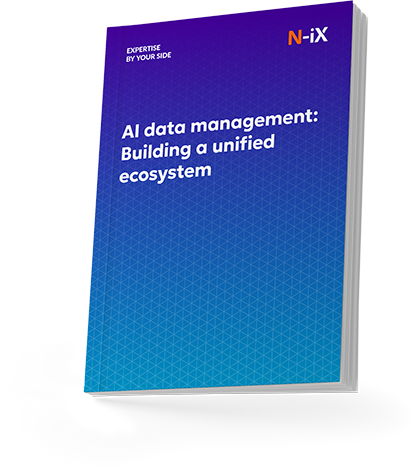On paper, the principles of effective data governance are clear: define roles, standardize data, and enforce policies. In reality, implementing data governance in a live enterprise environment involves navigating legacy systems, organizational silos, unclear ownership, and resistance to change, all while minimizing disruptions to critical operations.
What's needed is a structured, practical approach to data governance services: clear ownership, consistent policies, enforceable standards, and continuous oversight. Not theoretical models, but implementation frameworks that work in complex enterprise environments. This article is a practical guide for enterprise leaders who need data governance implementation that works, at scale, in production, under pressure. Let's get into it.
What components enable data governance implementation?
Implementing data governance at scale requires more than a technical framework-it necessitates a cohesive set of capabilities that can be tailored to various organizational contexts and business priorities. N-iX approaches governance holistically, ensuring every initiative aligns with enterprise strategy, operational workflows, and long-term value creation. The following components form the structural and behavioral foundation of effective data governance implementation:

Outcomes
Governance efforts must be anchored in the organization's strategic goals. Rather than focusing solely on compliance or control, the priority is to connect governance activities with measurable outcomes, such as faster decision-making, reduced risk, improved data quality, or regulatory readiness. Identifying and prioritizing these outcomes early ensures governance initiatives stay focused and can demonstrate a tangible return on investment.
Mandate and scope
A formal mandate provides the authority and structure needed to implement governance effectively. Typically, a data governance implementation plan includes senior-level sponsorship, funding, and clarity on the scope of governance activities. A well-defined mandate outlines which data domains are included, the governance model to be applied, and how efforts will coordinate with adjacent governance structures. Without a clear mandate, governance often lacks alignment and sustainability.
Decision rights
Clear and accountable decision rights are fundamental. Organizations must define who is responsible for which data assets, who has the authority to approve or deny access, and who oversees compliance with governance policies. These roles, encompassing data owners, stewards, and custodians, must be documented, communicated, and periodically reviewed to prevent overlap or gaps in accountability.
Processes
Governance processes provide the operational backbone for data management. These procedures include policies and workflows for data creation, quality control, sharing, retention, and access. Processes must be adaptable to different data domains and business contexts, while also being standardized enough to facilitate coordination across systems. Transparency, traceability, and continuous improvement are essential characteristics of a well-designed data governance implementation project plan.
Structure
An effective governance model relies on the proper organizational structure. What follows is a governance council or board, domain-specific data stewardship groups, and a coordinating office or working group to manage day-to-day operations. Clear role definitions help to align data governance strategy, execution, and oversight, and integrate into business-as-usual activities rather than a separate compliance exercise.
Culture
Long-term adoption of governance requires a data-literate culture and an active communication strategy. Data governance implementation involves ongoing education, clear messaging about governance objectives, and real-world examples of business value. A culture of collaboration helps teams see governance as a support mechanism rather than a barrier. Communication plans should also include feedback loops to adjust policies and priorities based on actual usage and outcomes.
Data governance doesn't fail because of tools or frameworks; it fails when it's disconnected from real business priorities, lacks ownership, or tries to scale before proving value. We build governance as an adaptive process.
How to implement data governance: key stages
N-iX aims to define the data governance implementation process based on what has worked in real enterprise environments. Drawing on our experience across industries and insights from leading frameworks, we outline a staged approach to ensure governance programs are practical, scalable, and aligned with business outcomes. Keep reading to explore the key data governance implementation steps we follow.
1. Launching with executive ownership and clear accountability
We begin by anchoring the initiative within the enterprise leadership. Executive sponsorship is essential for legitimacy, budget allocation, cross-functional coordination, and long-term traction. We help our clients establish a data governance council or steering committee composed of senior executives (e.g., CDO, CIO, COO) and domain leads from business and IT.
The role of this council is threefold:
- Set the strategic agenda for data governance aligned with business priorities.
- Resolve conflicts and enforce policy adoption across business units.
- Review progress and ensure accountability mechanisms are enforced.
Next, we co-develop a detailed responsibility model across the organization. This includes:
- Data owners (usually business-side leaders) are accountable for data quality, compliance, and value creation within their domain.
- Data stewards are responsible for defining and applying data rules, monitoring data integrity, and serving as day-to-day custodians of governance practices.
- Technical custodians or architects who verify that data is stored, processed, and transferred securely, and by governance policies.

Crucially, we tie these roles to measurable responsibilities, such as data quality KPIs, SLA adherence, or reduction of duplicated or stale data assets. According to McKinsey, organizations that embed governance roles into formal performance management systems report a 30-40% higher rate of adoption at mid-manager levels [2].
2. Selecting and scoping initial domains for execution
One of the most critical early-stage decisions is where to start. We deliberately avoid boiling the ocean. Instead, we help clients select one to two business-critical domains where governance can have an immediate operational and strategic impact. This aligns with the "minimum viable governance" (MVG) principle and reflects lessons from multiple industry reports, including DBHIDS and SEA-SRT, which emphasize incremental, use-case-driven rollouts.
We evaluate candidate domains based on:
- Strategic relevance: Is this domain core to revenue generation, risk mitigation, or operational efficiency?
- Regulatory exposure: Does it involve PII, financial data, or other high-risk elements?
- Data maturity and readiness: Are there known quality issues, conflicting definitions, or ownership gaps?
- Stakeholder engagement: Are there business leaders ready to support governance in this area?
We then help define a clear operational scope for each domain:
- Which systems store and process this data?
- What data assets and tables are in focus?
- Who are the producers and consumers of the data?
- Where are the current inconsistencies, risks, or bottlenecks?
3. Setting up governance workflows
At N-iX, we define data governance as a set of operational workflows embedded directly into how data moves across the organization. Being proactive means our team doesn't isolate governance into static policies but ensures it's fully integrated into daily processes, starting at data ingestion and continuing through validation, enrichment, sharing, reporting, and archiving. Within the implementation of data governance, we align these workflows with business-critical pipelines to enhance governance and deliver productivity and insight.
We focus heavily on operationalizing standards, rules, and quality checks where they matter most: inside existing data platforms, transformation pipelines, and analytics stacks. For instance, data lineage is captured at every handoff point, and validation rules are run automatically during ingestion or ETL. Whether you rely on Spark, dbt, Kafka, or legacy batch tools, our approach is based on applying governance functions continuously as part of the process.
Our team takes care that governance workflows are tightly aligned with AI/ML and regulatory priorities, as outlined in the data governance implementation plan. We define governance triggers that operate across high-value initiatives, such as model retraining, real-time analytics, and enterprise reporting. That means data flagged for poor quality or lineage issues doesn't just create a ticket; it halts incorrect downstream usage, alerts stewards, and initiates correction flows based on priority. From GDPR to ESG reporting and SOX, we embed compliance logic directly into the orchestration layer.
Build a unified, AI-driven data ecosystem—get the white paper!


Success!

4. Equipping teams with the right tools and training
Effective data governance implementation is impossible without the enabling infrastructure. We help enterprises deploy and operationalize tools that support governance, but only where they deliver real value. We avoid "tool-first" approaches and instead start from business needs and governance use cases.
We typically implement:
- Data catalogs to centralize metadata, stewardship info, and data definitions.
- Quality monitoring tools to detect and surface data issues in real-time.
- Lineage tracking to trace data flows and impacts across systems.
- Business glossaries to reduce ambiguity and improve consistency across units.
Critically, we don't stop at tool deployment. We work closely with client teams to configure these platforms in alignment with existing systems, priorities, and users. For example, we confirm that a lineage tool reflects how data flows across domains. We align quality alerts with operational Service Level Agreements so teams can take action.
Training is another core pillar. We design enablement programs for:
- Business users to help them understand the meaning, ownership, and policies of data.
- Data stewards and custodians to manage standards, resolve issues, and interpret metrics.
- Technical teams to build compliant pipelines and verify governance controls don't impair agility.
5. Executing in agile sprints
We treat data governance execution as a series of focused, high-impact delivery cycles. Each sprint targets a specific capability or domain, such as remedying poor data quality in a key operational dataset, reducing request backlogs for analytics teams, or integrating lineage and classification into a core workflow. Our goal is to produce measurable improvements from the outset, so that governance transitions from an abstract framework to tangible results. These improvements are tracked using metrics tied to business impact: turnaround times, data accuracy, and escalation rates.
Working in sprints also enables us to adapt quickly; if a policy doesn't gain traction, we iterate. If a stewardship model breaks down, we refine it to ensure its effectiveness. This agile, iterative model fosters trust, accelerates adoption, and enables leadership to see progress without waiting for a "big bang" transformation.
6. Monitoring adoption
We track performance across dimensions that matter: how fast are data requests fulfilled? How many escalations are being avoided due to clearer lineage or ownership? How often do stewards intervene? Our approach involves continuous monitoring of adoption and business value through agreed-upon KPIs. These may vary among data request cycle times, time-to-insight for reporting teams, issue resolution speed, or the rate of policy exceptions.
When gaps appear in adoption, we don't default to enforcement; we look for root causes. Is ownership unclear? Is the tooling misaligned with actual workflows? Are teams unaware of the benefits? We maintain open feedback loops, often facilitated through data councils or domain-specific working groups, to evolve governance as business needs change.
7. Scaling gradually
We treat scaling data governance as a controlled, outcome-oriented expansion of proven practices. Once governance workflows are validated in a pilot domain, such as finance, customer data, or supply chain, we move forward deliberately, extending scope based on demonstrated impact, stakeholder readiness, and operational maturity.
To guarantee consistency and efficiency while accommodating domain-specific needs, we employ a hybrid approach in data governance implementation roadmap: we standardize where possible and remain flexible where necessary. We maintain a central repository of reusable components and best practices to accelerate adoption across new areas, while still allowing for adaptation to regulatory, operational, or analytical nuances.
Key components we scale across domains include:
- Approved data taxonomies and naming standards for consistency across platforms and teams
- Templates for stewardship responsibilities and data ownership models that clarify roles without redundancy
- Predefined quality rules and validation logic that reflect enterprise-wide standards
- Shared tooling configurations (e.g., catalog tags, access controls, lineage definitions) optimized for enterprise interoperability
- Reusable change management and communication assets to educate and onboard domain teams efficiently
In parallel, we embed data governance into major transformation initiatives: cloud modernization, ESG tracking, and AI/ML deployment, where robust data controls are critical for both compliance and performance. Scaling gradually allows governance to evolve into a stable operating capability rather than a series of disconnected policies. It also provides space to monitor adoption, gather feedback, and refine frameworks before wider rollout, reviewing if governance remains aligned with business outcomes at every stage.

Read more: AI data governance: The key to scalable, secure, and reliable AI systems
Common challenges in data governance implementation
Companies that implemented fit-for-purpose governance frameworks achieved up to a 60% improvement in process efficiency, 50% faster data request processing, and a 70% reduction in time spent clarifying terminology [2]. That is a clear signal that a successful data governance implementation roadmap is achievable when common pitfalls are avoided. Continue reading to understand the limitations of implementing data governance and how to address them.
Governance programs designed without clear ownership models
Many data governance programs are designed with frameworks, glossaries, and policies, but lack defined accountability. In practice, this means no one is responsible for driving execution across business units. Programs stall when roles, such as data stewards or custodians, are assigned nominally but are unsupported by incentive structures, authority, or the capacity to enforce standards.
Governance decoupled from business priorities
Too often, data governance efforts begin with a theoretical or regulatory lens, rather than being tied to ongoing business priorities, such as operational efficiency, reducing regulatory risk, or expanding the market. Without a visible linkage to revenue, cost optimization, or customer experience improvements, governance becomes a background task rather than a business-critical function.
Overengineering governance frameworks early in the lifecycle
Many teams aim to build a "complete" model before implementation of data governance begins, designing comprehensive taxonomies, policies, lineage maps, and stewardship structures. The result is a slow, theoretical build-up that lacks real validation. Without early pilots tied to high-impact use cases, the program risks stagnating or becoming irrelevant to operational teams.
Misalignment between data governance and technology initiatives
Enterprise data platform modernization often runs in parallel with governance programs, but not in coordination with them. While new tools (e.g., data catalogs, lakehouses, lineage solutions) are deployed, the governance team may be defining policies in isolation. All of this results in disjointed outcomes: technical controls are available but not configured to align with governance policies, and data stewards struggle to enforce standards in fragmented environments.
Lack of change management
While executive buy-in is crucial, many governance rollouts are hindered by mid-level managers who control daily workflows and operations. These managers often bear responsibility for performance KPIs but are not included in governance design. If governance policies increase reporting burdens or slow down delivery without clear benefits, these managers may passively resist or deprioritize adoption.
This behavioral friction is widespread. Only 43% of organizations report their data stewardship efforts as mostly or entirely successful [3], highlighting how limited engagement and unclear expectations hinder adoption.
How do we approach data governance implementation to avoid the limitations?
- We address governance execution gaps by embedding clear ownership models into our delivery structure, defining roles such as data owners, stewards, and custodians with aligned authority, KPIs, and support.
- To prevent disconnection from business goals, we anchor each governance initiative in specific enterprise priorities, such as regulatory readiness, cost containment, or digital transformation metrics.
- Rather than designing exhaustive governance blueprints upfront, we initiate with scoped pilots tied to high-impact data domains for iterative refinement and improvement.
- Our teams bridge the governance-technology gap by aligning policy design with platform implementation, integrating standards directly into catalogs, lineage tools, and access controls.
- We invest early in change enablement by involving operational managers in shaping governance practices, ensuring the frameworks we deliver are usable, adopted, and supported at scale.
To illustrate how we executed data governance implementation into real enterprise environments, consider our collaboration with Gogo. We supported the client in launching a complex data governance initiative that consolidated over 20 data sources into a unified cloud platform. Our approach helped Gogo standardize definitions, control compliance across systems, and significantly improve data trust, without disrupting existing operations.
Explore more details: Big Data analytics for improved maintenance and flawless operation of the in-flight internet
In another engagement, we collaborated with a leading ecommerce provider to enhance data governance as part of a broader data platform modernization initiative. Our team helped the client build a data governance framework implementation plan and execute it across both AWS and Snowflake environments, enabling secure, compliant, and traceable analytics. Governance controls were established across ingestion, transformation, and reporting layers. We achieved that sensitivity, and customer data was properly handled while supporting the scalability of the new data platform.
Discover how we implemented data governance: Driving growth in ecommerce with a comprehensive data analytics solution
Final takeaways
When implemented correctly, data governance reduces operational risks, enhances data quality, and enables informed decision-making throughout the enterprise. However, it requires more than compliance checklists or new software; it takes a sustained effort to embed governance into the organization's actual operations.
If your governance initiative is stuck in pilot mode, delivering limited impact, or lacks real traction outside of data teams, now is the time to course-correct. Not through another policy draft, but through a focused data governance framework implementation plan: selecting measurable use cases, engaging the right people, tracking impact, and making governance part of how the business operates.
The organizations that get it right aren't the ones with the longest documentation; they're the ones where governance decisions happen daily, by design, without friction. So does your data governance program work when no one's watching?
Why is N-iX a trusted partner when it comes to implementing data governance?
- 23+ years of experience delivering enterprise-grade data and software solutions
- 60+ successful data and data governance projects across regulated and data-intensive industries
- 200+ data specialists with expertise in governance, analytics, and platform architecture
- 400+ cloud, certified professionals in AWS, Azure, GCP, and Snowflake
- Full-stack governance capabilities across AWS, Snowflake, and hybrid data platforms
- Agile implementation model delivering measurable outcomes in 8-12 week sprints
- Recognized by industry analysts, including ISG, IAOP, CRN, and Forrester
References
- Gartner Chief Data and Analytics Officer Agenda Survey - Gartner
- Designing data governance that delivers value - McKinsey
- Data governance management consulting - KMPG
Have a question?
Speak to an expert




